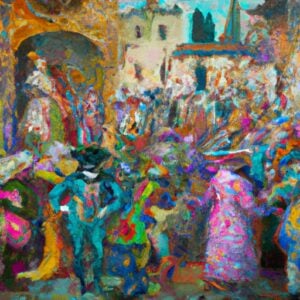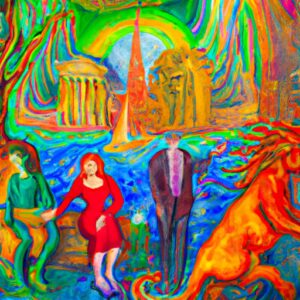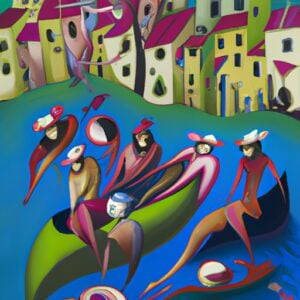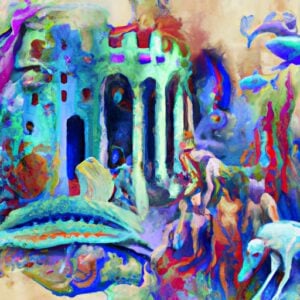.jpg)
html
Life in Italy during World War II was marked by significant social, political, and economic challenges. To understand the context, it is imperative to explore Italian society and culture before the war, Italy’s role in World War II, the impact of the war on Italian society, and everyday life during that time. Cultural and artistic expressions played a crucial role in shaping the experiences of Italians during this tumultuous period.
Italian society before World War II had a distinct economic and social structure. The country had a mix of agricultural and industrial sectors, with a significant proportion of the population still engaged in agriculture. The political landscape was dominated by Benito Mussolini’s fascist regime, which took power in the early 1920s. Mussolini’s government exercised strict control over society, limiting political freedoms and promoting nationalist ideologies. The cultural and artistic scene in Italy flourished during this time, with notable contributions in literature, art, and cinema.
Italy’s role in World War II was characterized by its alliance with Nazi Germany and the military campaigns it undertook. Under Mussolini’s leadership, Italy entered the war on the side of the Axis powers. The Italian military participated in campaigns in North Africa, the Balkans, and later joined Germany in the invasion of the Soviet Union. However, Italy faced significant challenges and suffered defeats, ultimately leading to the fall of Mussolini’s regime.
The impact of World War II on Italian society was profound. The country faced economic hardships, including food shortages and rationing, as resources were scarce. Social and political changes occurred, including the emergence of resistance movements against the fascist regime and German occupation. These resistance movements played a crucial role in opposing the occupiers and eventually supporting the Allied forces.
Everyday life during World War II in Italy was shaped by the hardships and disruptions caused by the war. Food shortages and the black market became prevalent, as resources were scarce and controlled. Mobility and transportation became difficult, with restrictions and disruptions in the infrastructure. The impact on women and children was significant, as they faced challenges in providing for their families and coping with the changing circumstances.
Despite the challenging circumstances, cultural and artistic expression continued to thrive during World War II in Italy. Literature and poetry reflected the experiences and emotions of the time, while film and theater provided an escape and a platform for storytelling. Visual arts and architecture also adapted to the wartime context, reflecting the political and social changes occurring in Italian society.
Understanding life in Italy during World War II requires an
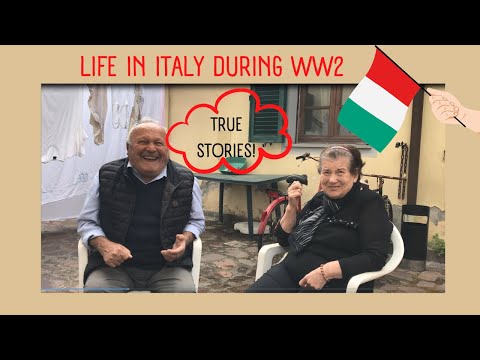
Italian Society and Culture before World War II
Italian society and culture had a vibrant and diverse tapestry before the outbreak of World War II. From the economic and social structure to the political landscape, and the cultural and artistic scene, each aspect played a crucial role in shaping the nation. Join me as we dive into the fascinating details of Italy’s pre-war society, exploring the societal structures, the political climate, and the flourishing artistic expressions that characterized the country during this pivotal period.
Economic and Social Structure
“The economic and social structure of Italy before World War II was characterized by significant disparities. Italy had an agrarian-based economy, with a large portion of the population engaged in farming or related activities. Compared to other European nations, Italy had a less developed industry and a lack of modern infrastructure. Socioeconomically, Italy had a hierarchical structure, with a small elite class at the top, followed by a middle class, and a majority of the population consisting of lower-income workers.
The fascist regime under Mussolini had a profound influence on Italy’s economic and social structure. The government implemented policies with the aim of promoting industrialization and reducing unemployment. These policies involved undertaking large-scale public projects, such as draining swamps and constructing infrastructure, in order to stimulate the economy. However, these initiatives often prioritized military spending over social welfare, resulting in limited improvements in living conditions for most Italians.
It is important to note that the economic and social structure of Italy underwent significant changes during World War II due to the impact of the conflict. The war caused widespread destruction, leading to further economic challenges and social disruptions. The loss of resources, coupled with increased government control and rationing, exacerbated existing inequalities within Italian society.
Fact: Italy experienced significant economic and social upheaval during World War II, with the fascist regime implementing policies aimed at industrialization and maintaining a strict social hierarchy.”
Political Landscape
The political landscape in Italy before and during World War II was shaped by the rise of Benito Mussolini and his fascist regime. Mussolini, who assumed power in 1922, established a totalitarian government that suppressed political opposition and consolidated power in the hands of the state.
Under Mussolini’s leadership, the National Fascist Party became the sole legal political party in Italy, effectively silencing any opposing voices. Civil liberties and freedom of speech were severely curtailed, and the regime relied on censorship and propaganda to manipulate public opinion.
Italy’s political landscape underwent further changes with Mussolini’s alliance with Nazi Germany. In 1936, Italy joined the Axis Powers and forged a close partnership with Adolf Hitler. This alliance solidified Mussolini’s control over the nation and aligned Italy’s foreign policy with the expansionist goals of Nazi Germany.
During World War II, Italy’s political landscape was dominated by the decisions and strategies of the fascist regime in relation to the war. Despite initial military successes, Italy encountered significant setbacks, particularly in North Africa and Greece. These military failures weakened the credibility of the regime and eroded popular support.
As the tide of the war turned against the Axis Powers, opposition to the fascist regime grew, leading to the establishment of resistance movements throughout Italy. Comprising various political factions and ideologies, these movements actively fought against the regime and played a significant role in ultimately liberating Italy.
The political landscape in Italy during World War II was characterized by the domination of Benito Mussolini and his fascist regime, the alliance with Nazi Germany, and the emergence of resistance movements against the regime. These political developments had profound ramifications for Italian society and the country’s role in the war.
Cultural and Artistic Scene
The cultural and artistic scene in Italy during World War II was a vibrant and diverse one, despite the challenges and restrictions imposed by the war. Throughout this period, various forms of artistic expression thrived, reflecting the social and political climate of the time.
- In the realm of literature and poetry, Italian writers and poets were deeply influenced by the war. They conveyed their emotions and thoughts through their works, delving into themes of resistance, loss, and hope.
- Despite the war, the realm of film and theater in Italy remained active and dynamic. Italian filmmakers continued to produce movies that authentically portrayed the realities of the time, giving birth to the Neorealist cinema movement. This cinematic genre depicted the harshness of war and its profound impact on society. The theaters also remained open, offering the public a means of escape and entertainment.
- The visual arts and architecture in Italy during the war exhibited a wide range of styles, from traditional to avant-garde. Artists effectively captured the experiences of wartime through their paintings, sculptures, and other visual artworks. Although architectural developments were limited due to the war, some remarkable projects still managed to emerge.
Italy’s Role in World War II
Italy’s immense significance during World War II cannot be underestimated. From Mussolini’s Fascist Regime to their alliance with Nazi Germany, and their military campaigns, Italy played a pivotal role. Delve into the pages of history as we uncover the fascinating sub-sections of Mussolini’s leadership, the alliance that shaped the course of the war, and the Italian military campaigns that unfolded. Brace yourself for a captivating journey into Italy’s crucial role during one of the most tumultuous periods in world history.
Mussolini’s Fascist Regime
In Italy was characterized by authoritarian rule and the promotion of nationalism and militarism. Under the leadership of Benito Mussolini, the regime gained power in 1922 and lasted until 1943. During this time, Mussolini sought to establish a totalitarian state with himself as the absolute ruler.
The regime employed various tactics to consolidate power and suppress opposition. Mussolini’s government created a cult of personality around him, using propaganda and censorship to control public opinion. The Fascist Party also established a secret police force, known as the OVRA, to monitor and suppress dissent.
One of the key aspects of Mussolini’s regime was its alliance with Nazi Germany. In 1939, Italy entered into a formal alliance with Germany, known as the Pact of Steel, which would have significant implications for Italy’s involvement in World War II.
Mussolini’s Fascist Regime also pursued expansionist policies, seeking to restore Italy to its former imperial glory. The regime carried out military campaigns in East Africa and Albania, but these efforts ultimately proved to be unsuccessful.
Mussolini’s Fascist Regime had a profound impact on Italian society and politics. It led to the erosion of democratic institutions and the concentration of power in the hands of the Fascist Party. The regime’s policies and actions also had far-reaching consequences during World War II and would shape the country’s future for decades to come.
Mussolini’s Fascist Regime in Italy was a period marked by authoritarian rule, suppression of dissent, and the pursuit of expansionist policies. It had a significant impact on Italian society and played a crucial role in Italy’s involvement in World War II. Understanding this era’s history is essential for comprehending the challenges and changes Italy faced during World War II.
[
Alliance with Nazi Germany
During World War II, Italy formed an alliance with Nazi Germany, known as the Alliance with Nazi Germany, which had a significant impact on the course of the war. This alliance, established under the leadership of Benito Mussolini and his Fascist regime, was driven by political and strategic reasons rather than ideological alignment. The Alliance with Nazi Germany provided Italy with crucial military support and resources from Germany, strengthening its position in the war.
The Alliance with Nazi Germany had both positive and negative implications for Italy. On the positive side, it allowed Italy to actively engage in large-scale military campaigns alongside Germany, including the invasion of France and other parts of Europe. Through this alliance, Italy had the opportunity to expand its territorial control and increase its influence.
However, the Alliance with Nazi Germany also brought negative consequences for Italy. As the war progressed, Italy became increasingly reliant on Germany for resources and military support. This dependence significantly limited Italy’s autonomy and decision-making capabilities. Additionally, Italy suffered heavy casualties and losses in its military campaigns, further weakening its position in the war.
Overall, the Alliance with Nazi Germany played a vital role in shaping Italy’s role in World War II. While it initially provided Italy with opportunities for expansion and influence, it eventually led to a decline in the country’s position and contributed to its eventual defeat.
Italian Military Campaigns
Italian Military Campaigns during World War II
| – Invasion of Ethiopia: In October 1935, Italy invaded Ethiopia with the aim of establishing an Italian colony. This campaign lasted until May 1936. |
| – Spanish Civil War: Italy supported the Nationalist faction led by General Francisco Franco during the Spanish Civil War from 1936 to 1939. Italian military assistance played a significant role in the Nationalist victory. |
| – Invasion of Albania: In April 1939, Italy invaded and occupied Albania, establishing it as an Italian protectorate. This campaign aimed to increase Italian influence in the Balkans. |
| – Invasion of Greece: In October 1940, Mussolini ordered an invasion of Greece, hoping for a swift victory. The Greek resistance and assistance from British forces forced the Italians to withdraw after several months of fighting. |
| – North African Campaign: Italy’s military campaign in North Africa, aimed at expanding its colonial empire, commenced in 1940. Italian forces faced strong resistance from British and Commonwealth troops, ultimately leading to their defeat in 1943. |
| – Invasion of Yugoslavia: In April 1941, Italy, along with Nazi Germany, invaded Yugoslavia. Italian forces faced difficulties and resistance from both the Yugoslav Partisans and other resistance groups. |
| – Invasion of the Soviet Union: Following the German invasion of the Soviet Union in June 1941, Italy sent troops to support the Axis offensive. Italian forces struggled against the harsh conditions and Soviet resistance, resulting in significant losses. |
Impact of World War II on Italian Society
During World War II, Italy experienced a profound transformation that reverberated throughout its society. From economic challenges and rationing to social and political changes, as well as the rise of resistance movements, the impact of this global conflict was deeply felt. In this section, we will explore how Italy’s economy struggled to adapt, how its social and political landscape changed, and the brave acts of resistance that thrived amidst adversity. Prepare to uncover the untold stories and understand the profound imprint left by World War II on Italian society.
Economic Challenges and Rationing
During World War II, Italy faced significant economic challenges and rationing. The economic challenges, driven primarily by the country’s involvement in the war, exerted immense pressure on Italy’s economy and resources. This led to widespread shortages and a strict system of rationing, where essential items such as food, clothing, and fuel became scarce.
To manage the limited resources, the Italian government implemented a system of rationing. Rationing cards were issued to individuals and families, specifying their allotted quantities of essential goods. These cards ensured that everyone received a fair share and prevented hoarding or black market activities.
Food, being one of the most heavily rationed items, became a major concern for Italians. They had to rely on meager portions of staples like bread, pasta, and sugar. Fresh produce and meat were particularly scarce, forcing people to make do with substitutes and preserved foods. Long queues formed outside rationing centers, and individuals often had to wait for hours to receive their rations.
Rationing measures extended beyond food to include basic necessities such as clothing, fuel, and household goods. People had to make do with limited supplies and find creative ways to stretch their resources.
The economic challenges and rationing during World War II in Italy had a profound impact on the daily lives of its citizens. The scarcity of resources forced people to adapt and make sacrifices to meet their basic needs, shaping their experiences throughout the war.
Social and Political Changes
During World War II, Italy witnessed significant social and political changes that had a profound impact on its society and politics. The rise of Mussolini’s fascist regime resulted in a transformation of the country’s political landscape, leading to restrictions on individual freedoms and the imposition of censorship on the media and public discourse. Moreover, the fascist government exerted its authority over key institutions, including the educational system, to mold public opinion in alignment with their ideology.
Italy’s alliance with Nazi Germany further shaped its society and politics. This collaboration influenced Italy to adopt anti-Semitic policies and actively participate in the persecution of Jews. It also led to an escalation of Italy’s military campaigns as they fought alongside the Axis powers.
The war’s effects on Italy’s social fabric were also profound. The economic challenges brought about by the conflict resulted in widespread poverty and scarcity, necessitating the rationing of essential goods such as food and fuel. The war also disrupted social dynamics, with women assuming roles traditionally held by men and children experiencing disruptions in their education and daily lives.
World War II ushered in tremendous social and political transformations in Italy, driven by the fascist regime, the alliance with Nazi Germany, and the hardships endured by Italian society. Understanding the history of Italy during this time allows us to grasp the profound impact of these changes on the lives of the Italian people.
Resistance Movements
- The Italian Resistance, also known as the Resistance Movements, was a widespread underground network that opposed the fascist regime of Benito Mussolini during World War II.
- These Resistance Movements were made up of various groups, including communists, socialists, liberals, and nationalists, all united in their desire to liberate Italy from fascist rule.
- The Resistance Movements engaged in acts of sabotage, guerrilla warfare, and intelligence gathering to undermine the fascist regime and support the Allied forces.
- They carried out attacks on military installations, transportation routes, and communication systems, disrupting the effectiveness of the Italian army and bureaucracy.
- The Resistance Movements also played a vital role in rescuing and protecting Italian Jews from deportation, saving thousands of lives.
- The contributions of the Resistance Movements were significant in weakening the fascist regime and ultimately leading to the downfall of Mussolini’s government.
In fact, the Italian Resistance was one of the most effective and organized resistance movements in occupied Europe, proving the determination and resilience of the Italian people in the face of oppression.
Everyday Life during World War II in Italy
Discover how daily life in Italy was transformed during World War II. From food shortages and the thriving black market to the challenges of mobility and transportation, and the profound impact on women and children, explore the fascinating realities faced by Italians during this tumultuous period. Uncover the struggles, resilience, and ingenuity that characterized everyday life on the home front, as Italy navigated through the challenges of war.
Food Shortages and Black Market
During World War II in Italy, the challenges of food shortages and the emergence of a black market were undeniable. The active population faced severe difficulties in accessing basic food items due to disruptions in the supply chain and restrictions imposed by the government. The scarcity of food resulted in a notable rise in prices and hoarding, giving birth to an underground market for illegal food trade.
Desperate to obtain essential commodities, people resorted to various means, often resorting to paying exorbitant prices on the black market. This illicit trade involved the sale of rationed products, including bread, pasta, and meat, as well as scarce goods like coffee, sugar, and tobacco. The black market provided individuals with a means to acquire these items that were otherwise unattainable through legal channels.
The consequences of food shortages and the subsequent black market were significant indeed. Many individuals struggled to adequately feed themselves and their families, leading to malnutrition and health issues. The existence of the black market not only exacerbated the already challenging economic situation, but it also fostered an atmosphere of distrust and corruption.
The government made efforts to combat the black market, implementing stricter regulations and penalties for those involved. However, these measures often proved inadequate as the demand for essential goods persisted.
The historical context of food shortages and the black market during World War II in Italy underscores the profound impact of war on everyday life and the desperate measures people had to take in order to survive. It serves as a testament to the resilience and resourcefulness of the Italian population in the face of adversity.
Mobility and Transportation Difficulties
During World War II in Italy, the population faced significant challenges in terms of mobility and transportation difficulties. The war profoundly impacted Italy’s infrastructure and transportation system, resulting in disruptions and limitations on people’s ability to move and access essential services.
These challenges in mobility and transportation created significant hardships for the Italian population during World War II, further exacerbating the already difficult conditions of everyday life in Italy at that time.
Impact on Women and Children
During World War II in Italy, the impact on women and children was substantial. The conflict brought social and economic challenges that forced women to assume new roles and responsibilities, as men were away serving in the military. Women had to step into positions in factories, farms, and other essential industries to keep the country running. Simultaneously, children faced significant obstacles as their lives were disrupted, and their education was frequently interrupted.
The war also had adverse effects on the health and well-being of women and children. The scarcity of food and resources resulted in malnutrition and health issues, especially among children. To ensure their families’ survival, women had to find innovative ways to provide for their loved ones.
Moreover, the constant fear and uncertainty of war took a toll on the mental and emotional well-being of both women and children. They had to endure bombings, separations, and the loss of family members, which deeply affected them.
In times of conflict, the safety concerns for women and children escalated. They were particularly vulnerable to violence, displacement, and exploitation, heightening the risks they faced.
However, it is vital to recognize the remarkable resilience and strength demonstrated by women and children during this challenging period in Italian history. Despite enduring hardships, they adapted to new circumstances and supported their families and communities.
Cultural and Artistic Expression during World War II in Italy
During World War II in Italy, amidst the chaos and uncertainty, cultural and artistic expression flourished. From the pages of literature and poetry to the captivating world of film and theater, as well as the mesmerizing strokes of visual arts and architecture, creativity knew no bounds. In this section, we will delve into the captivating realms of these sub-sections, exploring how they became a refuge for the Italian people, revealing the resilience, passion, and profound impact they had on the nation’s spirit.
Literature and Poetry
During World War II in Italy, literature and poetry played a significant role in conveying the experiences and emotions of the people living in those turbulent times. Many Italian writers and poets utilized their craft to express their thoughts, hopes, and fears during the war.
Italian literature and poetry during this period accurately depicted the realities of war, capturing the feelings of uncertainty, loss, and resilience. Writers such as Alberto Moravia and Italo Calvino masterfully portrayed the harsh realities of life under the Fascist regime and the impact of war on society.
Poets like Salvatore Quasimodo and Eugenio Montale skillfully utilized their verses to express the anguish and despair of the Italian people. Their works were abundant in poignant images and powerful emotions, effectively evoking the struggles and sacrifices made during the war.
Literature and poetry also emerged as a formidable form of resistance against the oppressive regime and Nazi occupation. Underground publications and clandestine writings circulated, providing a defiant voice for those who opposed the regime and fostering unity and resilience.
Through literature and poetry, Italians discovered solace, inspiration, and a means of preserving their culture and identity during the dark days of war. These artistic expressions persist as a powerful reminder of the strength and resilience of the Italian people during one of the most challenging periods in their history.
Film and Theater
During World War II in Italy, film and theater played a significant role in cultural expression and propaganda dissemination. Italian cinema faced challenges and changes under Mussolini’s fascist regime. The government exerted control over the film industry, promoting films that aligned with their ideologies and censoring those that didn’t. Film and theater makers often had to navigate political restrictions and self-censorship to continue their work.
Despite these challenges, Italian film and theater during World War II produced notable films that reflected the times. Some movies showcased patriotism and the glorification of the Italian military campaigns, while others explored themes of resistance and the struggles faced by ordinary people. The theater also thrived during this period, with performances that aimed to boost morale and provide an escape from the hardships of war.
One true story that illustrates the resilience and creative spirit during this time is the film “Roma, città aperta” (Rome, Open City) directed by Roberto Rossellini. It was filmed during the German occupation of Rome and told the story of ordinary people resisting the Nazi regime. Despite the challenging circumstances, the film was made with a low budget and limited resources, yet it became a groundbreaking work of Italian neorealism and a symbol of resistance.
“Roma, città aperta” and other films and theater productions of the era not only entertained audiences but also served as a powerful form of artistic expression and a reflection of the collective spirit during one of Italy’s most challenging periods.
Visual Arts and Architecture
Visual Arts and Architecture played a significant role during World War II in Italy. Despite the devastation caused by the war, artists and architects found ways to naturally express their creativity and contribute to the cultural scene of the time.
In the field of Visual Arts, Italian painters and sculptors depicted the realities and hardships of war through their works. Renato Guttuso and Marino Marini are renowned artists that effectively portrayed the suffering and resilience of the Italian people, capturing the raw emotions and struggles of the war-torn nation.
Architecture also underwent profound transformations during this tumultuous period. The fascist regime led by Mussolini promoted a grandiose architectural style known as “Rationalism,” intending to showcase the power and strength of the fascist government. Monumental buildings like the Palazzo della Civiltà Italiana in Rome were meticulously constructed to symbolize the ideology of the regime.
The war inevitably brought destruction to numerous cities, and architectural restoration became a top priority in the post-war years. Talented architects worked tirelessly to rebuild damaged structures, skillfully blending modernist and traditional elements to create a sense of continuity and renewal.
The Visual Arts and Architecture of Italy during World War II aptly reflect the historical magnitude of this period. They stand as a powerful testament to the resilience and boundless creativity of the Italian people in the face of immense adversity.
For those with a keen interest in delving deeper into this captivating era, visiting museums and historical sites can provide invaluable insights into the artistic expressions and architectural metamorphosis that unfolded during this pivotal time.
Frequently Asked Questions
What were the circumstances of Italy’s military effort in World War II?
Italy’s military effort in World War II has been criticized, but this was mainly due to the circumstances at the time. Mussolini declared war on France and Britain in June 1940, aiming to expand Italy’s colonial holdings in North Africa.
What were the major events in Italy during World War II?
Italy’s involvement in World War II started with joining Germany in June 1940, hoping for territorial gains. However, their initial attack on the French Alps was halted by the Franco-German armistice. The real war for Italy began in October 1940 with an attack on Greece, which ended in disaster. Italy lost its empire in eastern Africa and suffered heavy losses in Russia.
How did Italy’s factories contribute to the war effort during World War II?
During World War II, Italian factories were unable to produce weapons due to a shortage of raw materials and heavy Allied bombing. This led to a lack of resources for the war effort, hindering Italy’s military capabilities.
How did Italians experience everyday life during World War II?
The war greatly affected Italians’ daily reality, as they faced low morale, civilian bombings, food shortages, and strikes. The local Slavic population in certain territories supported armed resistance movements, while anti-Italian terrorism was widespread. Landowners in Sicily even formed armed bands against mainland interference.
When did anti-Fascist movements begin to revive in Italy during World War II?
Anti-Fascist movements began to revive in 1942 and 1943. The Communists organized strikes, and other political parties joined in opposition to fascism. Clandestine parties signed an agreement to work together to overthrow the fascist regime.
How did Italians perceive Fascism during World War II?
The chapter from “The Routledge History of the Second World War” explores how war affected Italians’ daily reality and shaped their opinion of Fascism. Historians have shown that Italians both suffered from the war and inflicted suffering on others. It challenges the previous narrative of victimhood and heroism, suggesting that anti-Fascism was not widespread until later in the war.


